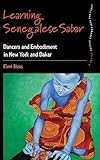Learning Senegalese Sabar : Dancers and Embodiment in New York and Dakar / Eleni Bizas.
Material type: TextSeries: Dance and Performance Studies ; 6Publisher: New York ; Oxford : Berghahn Books, [2014]Copyright date: ©2014Description: 1 online resource (168 p.)Content type:
TextSeries: Dance and Performance Studies ; 6Publisher: New York ; Oxford : Berghahn Books, [2014]Copyright date: ©2014Description: 1 online resource (168 p.)Content type: - 9781782382560
- 9781782382577
- 792.809663 23
- GV1588.6 .B59 2014eb
- online - DeGruyter
| Item type | Current library | Call number | URL | Status | Notes | Barcode | |
|---|---|---|---|---|---|---|---|
 eBook
eBook
|
Biblioteca "Angelicum" Pont. Univ. S.Tommaso d'Aquino Nuvola online | online - DeGruyter (Browse shelf(Opens below)) | Online access | Not for loan (Accesso limitato) | Accesso per gli utenti autorizzati / Access for authorized users | (dgr)9781782382577 |
Frontmatter -- Table of Contents -- Figures -- Acknowledgements -- Map of Senegal in Africa -- Introduction -- Chapter 1 Transatlantic Travels of West African Dance -- Chapter 2 The New York Dance Floor -- Chapter 3 Navigating Transatlantic Flows -- Chapter 4 Re-choreographing Sabar -- Chapter 5 The Kinaesthetic of Sabar -- Chapter 6 Hearing Movements, Seeing Rhythms -- Conclusion -- Glossary -- Bibliography -- Index
restricted access online access with authorization star
http://purl.org/coar/access_right/c_16ec
Based on extensive ethnographic fieldwork in New York and Dakar, this book explores the Senegalese dance-rhythms Sabar from the research position of a dance student. It features a comparative analysis of the pedagogical techniques used in dance classes in New York and Dakar, which in turn shed light on different aesthetics and understandings of dance, as well as different ways of learning, in each context. Pointing to a loose network of teachers and students who travel between New York and Dakar around the practice of West African dance forms, the author discusses how this movement is maintained, what role the imagination plays in mobilizing participants and how the ‘cultural flow’ of the dances is ‘punctuated’ by national borders and socio-economic relationships. She explores the different meanings articulated around Sabar’s transatlantic movement and examines how the dance floor provides the grounds for contested understandings, socio-economic relationships and broader discourses to be re-choreographed in each setting.
Mode of access: Internet via World Wide Web.
In English.
Description based on online resource; title from PDF title page (publisher's Web site, viewed 25. Jun 2024)


